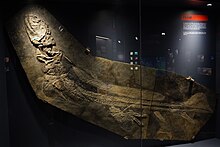| Lebachacanthus Temporal range: | |
|---|---|
 | |
| Specimen in Urzeitmeer-Museum | |
| Scientific classification | |
| Domain: | Eukaryota |
| Kingdom: | Animalia |
| Phylum: | Chordata |
| Class: | Chondrichthyes |
| Subclass: | Elasmobranchii |
| Order: | † Xenacanthida |
| Family: | † Diplodoselachidae Soler-Gijon, 1997 |
| Genus: | † Lebachacanthus Soler-Gijon, 1997 |
| Type species | |
| Lebachacanthus senckenbergianus (Fritsch, 1889) | |
| Other species | |
| |
| Synonyms | |
| |
Lebachacanthus is a genus of extinct xenacanth cartilaginous fish known from the late Carboniferous-Early Permian of Europe. [1] Well-preserved specimens, originally identified as Orthacanthus , are known from Meisenheim Formation in Germany. [2] During the late Paleozoic, xenacanths were the apex predators of freshwater ecosystems, preying on small amphibians. [3]






